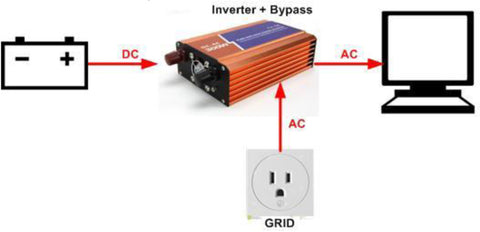Power Inverter FAQ
What is an inverter?
Why should I use a Pure Sine Wave inverter instead of a Modified Sine Wave inverter?
There are very good reasons to choose Pure Sine Wave (PSW) or True Sine Wave (TSW) inverters over Modified Sine Wave (MSW) inverters:
- Output voltage wave form is PSW with very low harmonic distortion and clean power, just like utility-supplied (grid) electricity
- MSW work acceptably with resistive loads (ex. bulbs) but not with inductive or capacitive loads
- Inductive loads like MW ovens and motors run faster, quieter and cooler. With MSW appliance may use 20% more power than it would if using a PSW. This extra power usage may damage or shorten the life of the appliance
- Reduces audible and electrical noise in fans, fluorescent lights, audio amplifiers, TV, Game consoles, Fax
- Prevents crashes in computers, weird print out, and glitches and noise in monitors
- PSW reliably powers the following devices that will normally not work with MSW inverters:
|
|
|
|
|
|
|
|
|
|
|
|
- Some appliances like MW and variable speed motors will not produce full output if they do not use PSW power
- Other devices, particularly medical equipment may not function at all unless you use a PSW inverter
- A TSW produces a much higher equivalent wattage compared to a MSW inverter. It is somehow believed that the more you will be using this type of inverter, the greater the variety of electrical devices and appliances you will be powering.

Figure above shows PSW vs. MSW
How do I choose the right inverter to power my appliances?
- For resistive loads you can choose the same power as the load, or higher.
- For capacitive loads, depending on the load, you can choose an inverter with 2 to 5 times the load power.
- For inductive loads, depending on the specific load, you can choose an inverter with 4 to 7 times the load power.
- For ex. say you intend to power:
|
|
|
FAQs in ABC order:
- Battery considerations:
|
|
|
|


|
|
|
| Inverter Size | < 3 ft | 3ft - 6ft | 6ft - 10ft |
| 300 Watts | 8 | 6 | 4 |
| 600 Watts | 6 | 4 | 2 |
| 1000 Watts | 4 | 2 | 1/0 |
| 1500 Watts | 2 | 1 | 3/0 |
| 2000 Watts | 1/0 | 2/0 | 250 |
| 2500 Watts | 1/0 | 3/0 | 350 |
| 3000 Watts | 3/0 | 4/0 | 500 |

| DC input 12V | DC Input 24V | DC Input 48V or higher |
| 88% | 90-92% | 94% |
*Efficiency = Pout / Pin x 100% = [(Vout x Iout) / (Vin x Iin)] x 100%



MPPT vs PWM
Solar controller technologies MPPT and PWM are currently available. However our data shows that conversion efficiency of PWM controllers is less than 70%, while MPPT controller conversion efficiency reaches 95 to 97%. The MPPT solar controller is typically more expensive but the corresponding solar modules are more expensive. Using MPPT controller you can reduce solar module cost, and the overall cost of your solar system.
Battery Work hours = Battery Capacity * Battery Voltage * 0.8 / Load Power (H = AH * V * 0.8 / W)

